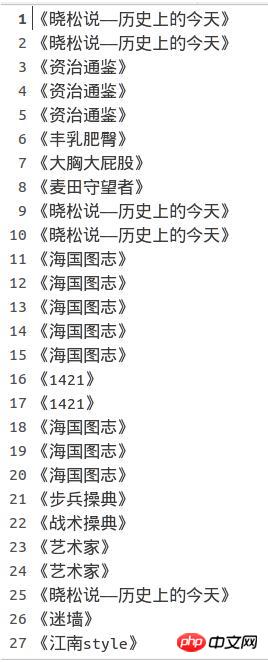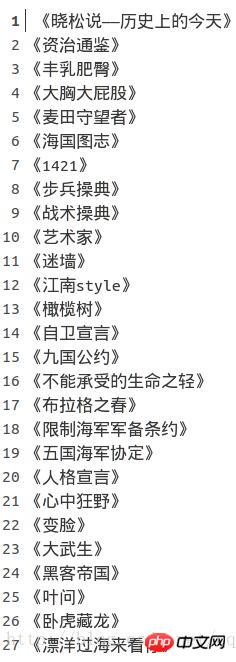Rumah >pembangunan bahagian belakang >Tutorial Python >python3.4.3下逐行读入txt文本并去重的方法
python3.4.3下逐行读入txt文本并去重的方法
- 不言asal
- 2018-05-02 16:17:422989semak imbas
这篇文章主要介绍了关于python3.4.3下逐行读入txt文本并去重的方法,有着一定的参考价值,现在分享给大家,有需要的朋友可以参考一下
读写文件时应注意的问题包括:
1.字符编码
2.操作完成即时关闭文件描述符
3.代码兼容性
几种方法:
#!/bin/python3
original_list1=[" "]
original_list2=[" "]
original_list3=[" "]
original_list4=[" "]
newlist1=[" "]
newlist2=[" "]
newlist3=[" "]
newlist4=[" "]
newtxt1=""
newtxt2=""
newtxt3=""
newtxt4=""
#first way to readline
f = open("duplicate_txt.txt","r+") # 返回一个文件对象
line = f.readline() # 调用文件的 readline()方法
while line:
original_list1.append(line)
line = f.readline()
f.close()
#use "set()" remove duplicate str in the list
# in this way,list will sort randomly
newlist1 = list(set(original_list1))
#newlist1 = {}.fromkeys(original_list1).keys() #faster
#rebuild a new txt
newtxt1="".join(newlist1)
f1 = open("noduplicate1.txt","w")
f1.write(newtxt1)
f1.close()
###################################################################
#second way to readline
for line in open("duplicate_txt.txt","r+"):
original_list2.append(line)
newlist2 = list(set(original_list2))
newlist2.sort(key=original_list2.index) #sort
#newlist2 = sorted(set(original_list2),key=l1.index) #other way
newtxt2="".join(newlist2)
f2 = open("noduplicate2.txt","w")
f2.write(newtxt2)
f2.close()
###################################################################
#third way to readline
f3 = open("duplicate_txt.txt","r")
original_list3 = f3.readlines() #读取全部内容 ,并以列表方式返回
for i in original_list3: #遍历去重
if not i in newlist3:
newlist3.append(i)
newtxt3="".join(newlist3)
f4 = open("noduplicate3.txt","w")
f4.write(newtxt3)
f4.close()
###################################################################
#fourth way
f5 = open('duplicate_txt.txt',"r+")
try:
original_list4 = f5.readlines()
[newlist4.append(i) for i in original_list4 if not i in newlist4]
newtxt4="".join(newlist4)
f6 = open("noduplicate4.txt","w")
f6.write(newtxt4)
f6.close()
finally:
f5.close()
结果:
去重前:

去重后(无序):

去重后(有序):

总结
这段下程序涉及文件读写操作以及链表List的操作,文章开头提到的几个问题,由于并没有使用中文,所以不关心编码,但这里还是要提一提:
f = open("test.txt","w")
f.write(u"你好")
上面这段代码如果在python2中运行会报错

报错是因为程序没办法直接保存unicode字符串,要经过编码转换成str类型的二进制字节序列才可以保存。
write()方法会自动编码转换,默认使用ascii编码格式,而ascii不能处理中文,所以出现UnicodeEncodeError。
正确方式是在调用write()方法前,手动格式转换,用utf-8或者gbk转换成str。
f = open("test.txt","w")
text=u"你好"
text=text.encode(encoding='utf-8')
f.write(text)
关于close()问题:
不关闭会有什么影响呢?操作完成后,不关闭文件,会对系统资源造成浪费,因为系统可打开的文件描述符数量是有限的。Linux是65535。
一般来说close之后就OK了,但是也会存在特殊情况,比如说,在调用open()函数时就已经发生错误,权限不足,调用close()肯定报错。还有一种是在write()时,如果磁盘空间不足,报错,close()就没有机会执行了。正确的做法就是使用 try except 对异常进行捕获:
f = open("test.txt","w")
try:
text=u"你好"
text=text.encode(encoding='utf-8')
f.write(text)
except: IOError as e:
print("oops,%s"%e.args[0])
finally:
f.close()
更优雅的写法是用 with…as。
with open("test.txt","w") as f:
text=u"你好"
f.write(text.encode(encoding='utf-8'))
文件对象实现上下午管理器协议,程序进入with语句时,会把文件对象赋值给变量f,在程序退出with时会自动的调用close()方法。
关于兼容性问题:
python2和python3的open()函数是不一样的,后者可以在函数中指定字符编码格式。
如何解决python2和python3的兼容open()问题呢?
使用io模块下的open()函数,python2中的io.open等价与python3的open函数
from io import open
with open("test.txt","w",encoding='utf-8') as f:
f.write(u"你好")
相关推荐:
python下解压缩zip文件并删除文件的实例_python
Atas ialah kandungan terperinci python3.4.3下逐行读入txt文本并去重的方法. Untuk maklumat lanjut, sila ikut artikel berkaitan lain di laman web China PHP!

